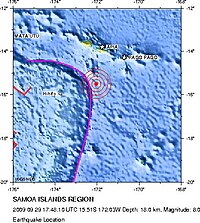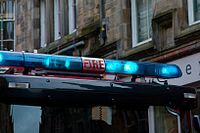Death toll from tsunami in Southeast Asia increases
Correction — May 8, 2018
This headline incorrectly locates the tsunami in Southeast Asia; it was in the South Pacific, as stated in the lede.
Thursday, October 1, 2009
A tsunami that was generated in the South Pacific by a powerful undersea earthquake has killed at least 110 people, according to authorities.

The majority of the fatalities occurred in Samoa, where rescue workers say at least 84 people were killed. Another 24 people are confirmed dead on American Samoa, while at least seven fatalities have been reported in nearby Tonga.
The US Geological Survey says an 8.0 magnitude earthquake struck early Tuesday local time. It generated waves that devastated coastal areas, knocked down buildings and sent cars floating out to sea.
Strong aftershocks followed the initial earthquake, with at least one measuring a magnitude 5.6. Tsunami alerts were issued for the entire South Pacific region but were later canceled. Survivors fled to high ground and stayed there for hours.
Samoa
Several villages were destroyed on the southern Samoan coast of Upolu, which is also home to many tourist resorts.
During a flight on from Auckland, New Zealand to Apia, Samoa, Samoan Prime Minister Tuilaepa Sailele Malielegaoi told reporters he was shocked by the disaster. "So much has gone. So many people are gone. I'm so shocked, so saddened by all the loss."
"The situation is very bad," said Marie-Francoise Borel, a spokesperson for the International Red Cross, to the CTV News Channel by telephone. "This massive wave has swept across - it's destroyed villages, it's destroyed homes, people are in shock."
The assistant chief executive of Samoa's disaster management predicted that the death toll in the country could surpass one hundred, saying that searches for bodies in the region are still ongoing.
"They are still continuing the searches for any missing bodies in the area. Some areas have been flattened and the tsunami had brought a lot of sand onshore, so there have been reports the sand has covered some of the bodies. So we need specialised machines to search for bodies that are buried under the sand," he said.
The communications head for the International Federation of the Red Cross, Jason Smith, told the Al Jazeera news agency that the Red Cross "[...] is working hard through five evacuation centres to provide people with safe places to stay and access to clean water," estimating that up to 15,000 people in sixty villages were affected by the tsunami.
American Samoa
At the capital of American Samoa, Pago Pago, the tsunami measured 1.57 meters in height. The superintendent of the National Park of American Samoa Mike Reynolds reported four waves as high as six meters. People who experienced the quake said it was long, lasting from 90 seconds to three minutes.
| We're focused on bringing in the assistance for people that have been injured, and for the immediate needs of the tens of thousands of survivors down there. | ||
—Craig Fugate, FEMA administrator | ||
Pago Pago city streets were strewn with overturned vehicles, cars, and debris. Some buildings located only slightly above sea level were completely destroyed by the waves, and power in some locations is not expected to be restored for up to a month. FEMA administrator Craig Fugate said that "we're focused on bringing in the assistance for people that have been injured, and for the immediate needs of the tens of thousands of survivors down there."
"The first federal team members are currently en route to American Samoa aboard a Coast Guard plane and will be providing on the ground assessments once they arrive on the island," Fugate said. "FEMA, who has provisions pre-positioned in a distribution center in Hawaii, is also preparing to send supplies as needed to help meet the immediate needs of the survivors."
Didi Afuafi, 28, who was riding on a bus in American Samoa when the tsunami struck, described her experiences. "I was scared. I was shocked. All the people on the bus were screaming, crying and trying to call their homes. We couldn't get on cell phones. The phones just died on us. It was just crazy," she said. "This is going to be talked about for generations."
US President Barack Obama declared a major disaster in American Samoa, and has sent federal aid to support local recovery efforts in the US territory.
"My deepest sympathies are with the families who lost loved ones and many people who have been affected by the earthquake and the tsunami," Obama said. He had earlier pledged in a written statement to give a "swift and aggressive" government response to the disaster.
"I am closely monitoring these tragic events, and have declared a major disaster for American Samoa, which will provide the tools necessary for a full, swift and aggressive response," Obama said.
During a Wednesday appearance near Washington, D.C., the president said the US was ready to help its "friends" in neighboring Samoa and throughout the region.
Tonga
In Tonga, seven people were confirmed dead and another three missing, after waves struck Niuatoputapu, a northern island. Acting prime minister Lord Tuita said in a statement that "according to information gathered from Niuatoputapu so far, seven people are confirmed dead, three missing and four with very serious injuries," Lord Tuita, the acting prime minister, said in a statement. "It is reported that the tsunami did serious damage to the village of Hihifo, which is like the capital of the island.
"The hospital on the island is reported to have suffered major damage; telephone communication has been cut as a result of damage to equipment and facilities on the island; homes and government buildings have been destroyed," he said.
An airplane was reportedly chartered by Tongan authorities to determine the amount of damage done to Niuatoputapu, but wasn't able to land.
Sources
- Tsunami Death Toll Rises in Southeast Asia <broken link> [archived version] — VOA News, September 30, 2009
- "Aid flows to tsunami victims in the South Pacific" — CTV Toronto, September 30, 2009
- "Aid flows to tsunami-hit Samoas as deaths hit 119" — The Associated Press, September 30, 2009
- "Obama expresses 'deepest sympathy' over Samoa tsunami" — Associated Press, September 30, 2009
- "Scores dead after Pacific tsunami" — Al Jazeera, September 30, 2009
